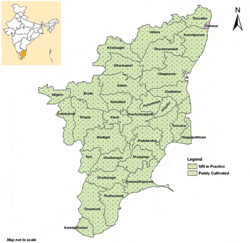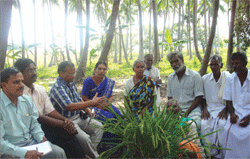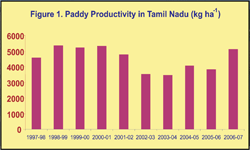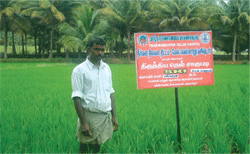|
|
 |
|
| SRI Fact Sheet - Tamilnadu |
|
| Total geographical area (km2) |
1,30,069 |
| Total population (million) |
66.4 |
| Total cultivable area (million ha) |
7.99(2001-02) |
| Total paddy area (million ha) |
1.93 (2006-07) |
| Paddy area (%) to total cultivable area |
24.16 |
| Major rice season(s) |
Jun – Sep, Aug – Jan, Dec– Apr |
| Total paddy production (million tonnes) |
9.92(2006-07) |
| State’s contribution to national paddy production (%) |
7.08 |
| Paddy productivity (t ha-1) |
5.14(2006-07) |
| All-India rank in productivity |
2 |
| Constraints in paddy cultivation |
Water & labour |
|
 |
|
|
| |
|
 Background Background
Tamil Nadu is the southern-most state in India. The total rice area in 2005-06 was 2.05 m ha. Season-wise areas
were 15.7 per cent in kuruvai (Jun.- Oct.), 74.7 per cent in samba (Aug.-Jan.) and 9.6 per cent in navarai (Dec.- Apr.). Rice is grown in all 30 districts of the state except Chennai and the top five districts with a higher rice area were Villupuram (8.2%), Nagapattinam (7.7%), Thiruvarur (7.6%), Thanjavur (7.55%) and Thiruvannamalai (6.99%). The total paddy production was 7.83 million tonnes (5.2 million tonnes of rice, which was 84.3% of the total food-grain production in the state) in 2005-06, but had increased to 9.92 million tonnes in 2006-07. Tamil Nadu ranks twelfth in total rice production in the country.
 Paddy productivity in Tamil Nadu has always been the second highest in the country, next only to Punjab. During Paddy productivity in Tamil Nadu has always been the second highest in the country, next only to Punjab. During
1998-99 and 1999-2000, the state average productivity was higher than Punjab. Over the last decade, average productivity ranged from 3462 kg ha-1 to 5369 kg ha-1 (Figure 1). However, productivity enhancement was required to fill ever increasing demand. Water scarcity was a major problem, its availability being dictated by the monsoon.
There was an urgent need to reduce water consumption for rice cultivation while enhancing productivity. The System of Rice Intensification (SRI) fit the bill neatly and thus became an important focus for agricultural research and extension.
SRI was made known to the Tamil Nadu Agricultural University (TNAU) through an informal email communication from Plant Research International (PRI), Wageningen, in early 2000. The innovative concepts led to an explorative evaluation immediately. The results clearly showed the applicability of wider spacing and non-flood irrigation. At this juncture, PRI initiated a collaborative research project 'Waterless Rice' of which TNAU was part. SRI principles were introduced in the experiments of this project. The result of the first experiment itself threw light on the impact of weeder operation and water saving. There was a significant increase in yield (630 kg ha-1) due to the use of the weeder, which generated a lot of interest. There was no yield difference due to less irrigation. Further research continued at Coimbatore, Aduthurai, Thanjavur, and Killikulam not only by scientists but also postgraduate students.
Based on the field experiments conducted in Coimbatore during 2000-2002, a package of SRI practices were evolved. Nursery preparations were modified. The package was tested in 100 farmers' fields in 2003 through a state Government initiative to evaluate the performance in comparison with conventional cultivation in two river basins viz. Cauvery and Tamiraparani. The results showed an average increase in grain yield by 1.5 t ha-1 in both basins. SRI was thus officially recommended for adoption by farmers in 2004. By this time some farmers had already embraced SRI.
In 2004, Government of Tamil Nadu implemented a pilot project funded by World Bank in Adavinayinar river basin (part of Tamiraparani basin) in which enhancing water-use efficiency was a key objective. TNAU was involved in this project and SRI was demonstrated to farmers both by TNAU and the Department of Agriculture. Positive results from this pilot project paved the way for the implementation of a fiveyear project, Irrigated Agriculture Modernization and Waterbodies Restoration and Maintenance (IAMWARM) by World Bank in 63 river basins from 2007, with a budget allocation of Rs.24,000 million. SRI was included in this project as a major thrust in the agriculture component. In the first phase, nine basins were covered during 2007-08. Sixteen more were covered from 2008-09 and the remaining 38 basins will be taken up from 2009-10. In this programme, enlisted farmers are given training, inputs, SRI tools (weeder and marker), technical assistance and constant monitoring to implement SRI.
The Department of Agriculture of the Government has included SRI in all existing and new schemes funded by Governement of India that focus on increasing food production. During 2007-08, SRI was demonstrated in 11,320 ha under the Integrated Cereal Development Programme (ICDP) by extending a subsidy of Rs.2000 per ha and imparting training to 56,600 farmers. This led to the spread of SRI in 0.42 million ha during that year. Triggered by the success during the previous year, the Department has embarked on scaling up SRI in 0.75 million ha during the current year (2008-09).
|
| |
Performance
The first experimental result conducted at Coimbatore in 2000 showed statistically higher yield (10.9%) due to weeder-use and paved way for fur ther evaluation. The adaptive research trials in farmers' fields in Tamiraparani basin with a package of practice showed that grain yields recorded under SRI and conventional cultivation ranged from 4214 to 10655 kg ha-1 (STDEV: 1379) and 3887 to 8730 (STDEV: 1108) kg ha-1, respectively. The mean grain yield was 7227 and 5657 kg ha-1, respectively, showing an average yield advantage of 1570 kg ha-1 under SRI. Nearly 31 farmers recorded yields of more than 8 t ha-1 under SRI against three farmers using conventional cultivation. The maximum yield advantage recorded by a farmer in SRI was 4036 kg ha-1 (70% higher than conventional cultivation).
Further trials conducted at Aduthurai and Thanjavur showed that adopting all SRI components resulted in 48.8 per cent higher yield at Aduthurai and 35.8 per cent higher yield at Thanjavur when compared with conventional cultivation. A systematic study also showed that among the SRI components, the major effect was by weeder-use followed by single seedling per hill.
With shallow irrigation in the experiments conducted during 2000-2002 at Coimbatore, there was 39-52 per cent water saving with water productivity increase of 53-96 per cent.
 The grain yields in SRI obtained by farmers taking part in IAMWARM project ranged from 2948 kg ha-1 (Aliyar basin) to 9987 kg ha-1 (Upper Vellar basin). The per cent increase yield in SRI over conventional cultivation ranged from 16.3 to 46.5. The grain yields in SRI obtained by farmers taking part in IAMWARM project ranged from 2948 kg ha-1 (Aliyar basin) to 9987 kg ha-1 (Upper Vellar basin). The per cent increase yield in SRI over conventional cultivation ranged from 16.3 to 46.5.
The state Department of Agriculture has reported a maximum grain yield of 14.2\ t ha-1 by a farmer in Dindigul district. |
| |
Experiences in Adoption
The extension of the SRI technique was slow owing to the apprehensions surrounding the principles of SRI. However, convincing success stories from farmers have enabled scaling up SRI adoption. SRI is attractive to organic farmers.
Drastic changes in the agronomic practices of SRI initially failed to build confidence amongst the farmers. Only when a crop with profuse tillering was raised with repeated weeder use was confidence built. Thus 'seeing is believing' is true in SRI adoption. Drastic reduction in seed-rate was itself a major benefit the farmers could appreciate. In some villages a community nursery concept has been introduced. The initial mind-block of labourers, especially with regard to square planting, sometimes slows down the interest of the farmers.
Like anywhere else, SRI famers tend to modify the technique to suit their convenience, especially in weeder use. The drudgery in weeder operation is one of the major constraints. Many farmers use the weeder in one direction only.
SRI has revived rice cultivation in labour-scarce areas because of the several advantages. Farmers who use ground water for rice cultivation very well recognize the less use of water.
The yield advantage has been realized by farmers with all the varieties used by them. Farmers who are involved and committed continue with SRI.
The coverage on SRI by media viz., newspapers, magazines, All India Radio, TV channels has been excellent in Tamil Nadu. |
| |
Way Forward
The continued effor ts of TNAU and the commitment of the Department of Agriculture has been the major force in scaling up SRI, while appreciable efforts are also being taken up by some NGOs There are several leaders in both TNAU and the department whose commitments have brought many farmers in to SRI. Farmer leaders for SRI also are emerging. It is necessary to encourage such leaderships in SRI scaling up. Training and exposure visits are crucial in bringing in new farmers in to SRI fold. Thus, the role of extension personnel is critical. |
| |
|
|
| |
|